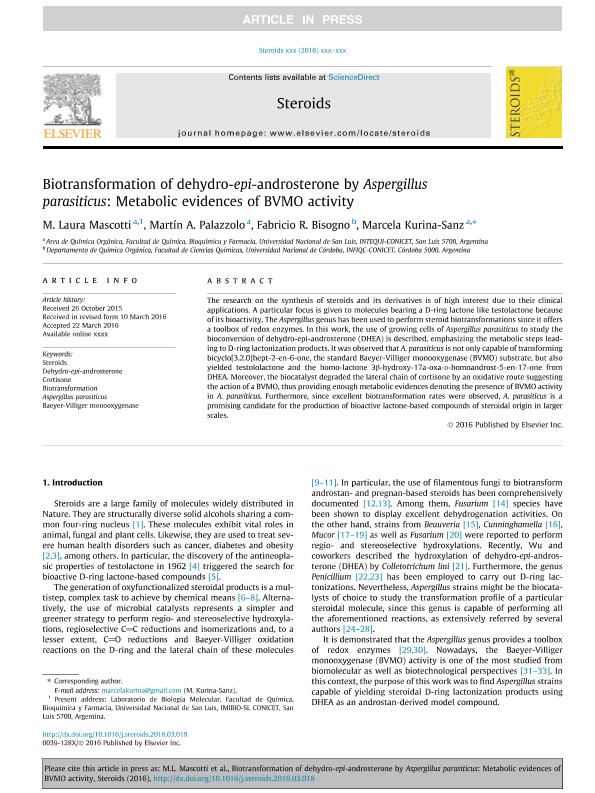Artículo
Biotransformation of dehydro-epi-androsterone by Aspergillus parasiticus: Metabolic evidences of BVMO activity
Mascotti, María Laura ; Palazzolo, Martín Alejandro
; Palazzolo, Martín Alejandro ; Bisogno, Fabricio Román
; Bisogno, Fabricio Román ; Kurina Sanz, Marcela Beatriz
; Kurina Sanz, Marcela Beatriz
 ; Palazzolo, Martín Alejandro
; Palazzolo, Martín Alejandro ; Bisogno, Fabricio Román
; Bisogno, Fabricio Román ; Kurina Sanz, Marcela Beatriz
; Kurina Sanz, Marcela Beatriz
Fecha de publicación:
05/2016
Editorial:
Elsevier Science Inc
Revista:
Steroids
ISSN:
0039-128X
Idioma:
Inglés
Tipo de recurso:
Artículo publicado
Clasificación temática:
Resumen
The research on the synthesis of steroids and its derivatives is of high interest due to their clinical applications. A particular focus is given to molecules bearing a D-ring lactone like testolactone because of its bioactivity. The Aspergillus genus has been used to perform steroid biotransformations since it offers a toolbox of redox enzymes. In this work, the use of growing cells of Aspergillus parasiticus to study the bioconversion of dehydro-epi-androsterone (DHEA) is described, emphasizing the metabolic steps leading to D-ring lactonization products. It was observed that A. parasiticus is not only capable of transforming bicyclo[3.2.0]hept-2-en-6-one, the standard Baeyer-Villiger monooxygenase (BVMO) substrate, but also yielded testololactone and the homo-lactone 3β-hydroxy-17a-oxa-d-homoandrost-5-en-17-one from DHEA. Moreover, the biocatalyst degraded the lateral chain of cortisone by an oxidative route suggesting the action of a BVMO, thus providing enough metabolic evidences denoting the presence of BVMO activity in A. parasiticus. Furthermore, since excellent biotransformation rates were observed, A. parasiticus is a promising candidate for the production of bioactive lactone-based compounds of steroidal origin in larger scales.
Archivos asociados
Licencia
Identificadores
Colecciones
Articulos(INFIQC)
Articulos de INST.DE INVESTIGACIONES EN FISICO- QUIMICA DE CORDOBA
Articulos de INST.DE INVESTIGACIONES EN FISICO- QUIMICA DE CORDOBA
Articulos(INTEQUI)
Articulos de INST. DE INVEST. EN TECNOLOGIA QUIMICA
Articulos de INST. DE INVEST. EN TECNOLOGIA QUIMICA
Citación
Mascotti, María Laura; Palazzolo, Martín Alejandro; Bisogno, Fabricio Román; Kurina Sanz, Marcela Beatriz; Biotransformation of dehydro-epi-androsterone by Aspergillus parasiticus: Metabolic evidences of BVMO activity; Elsevier Science Inc; Steroids; 109; 5-2016; 44-49
Compartir
Altmétricas



